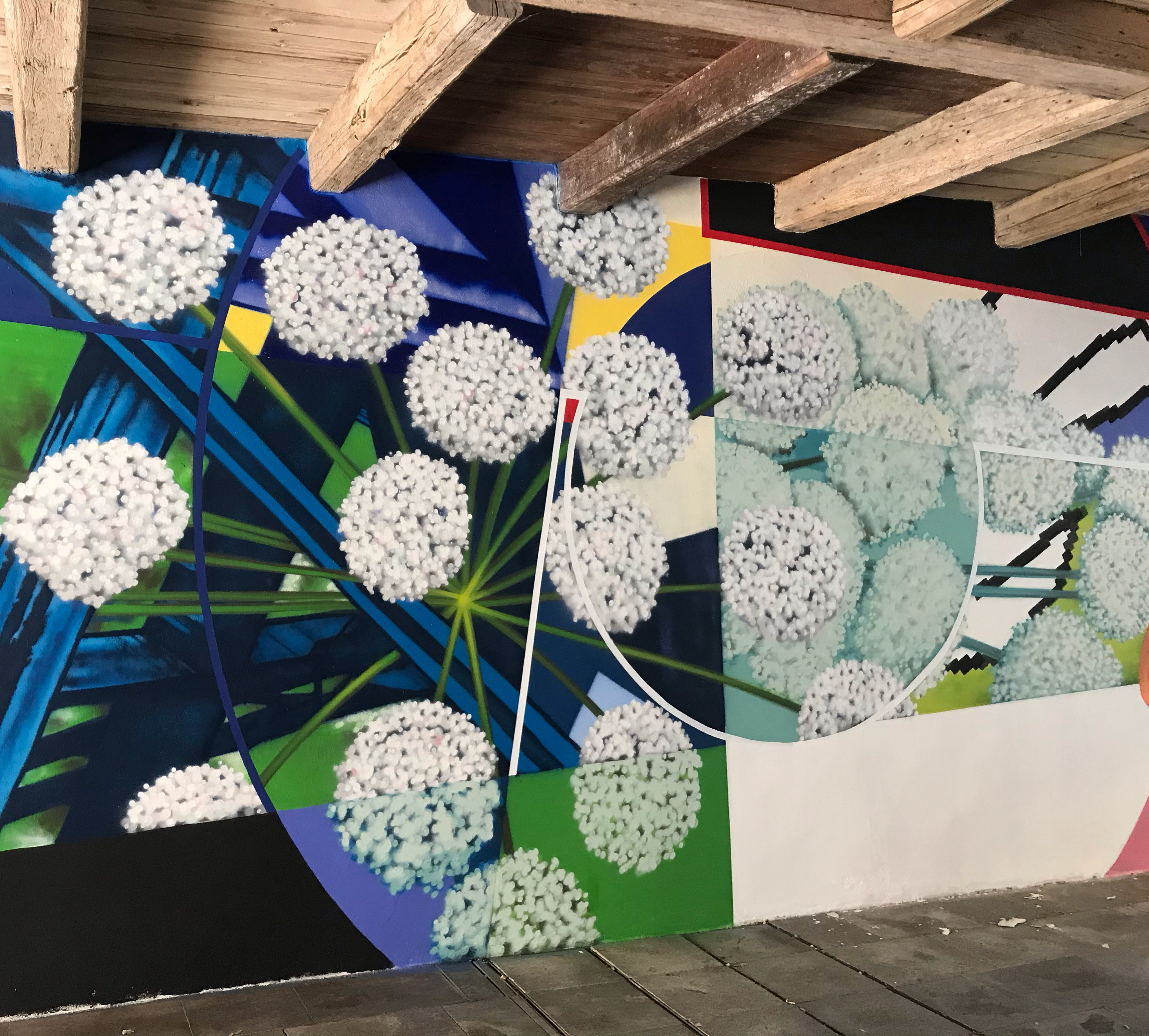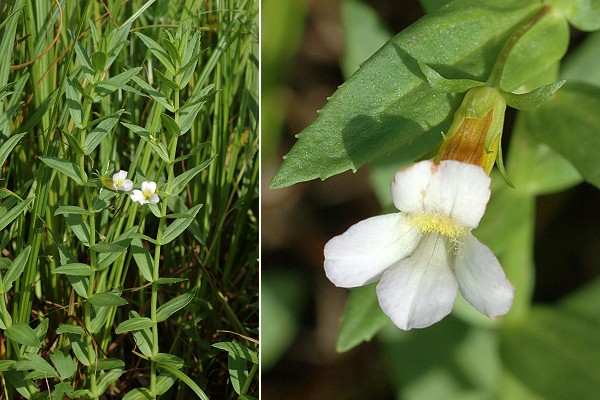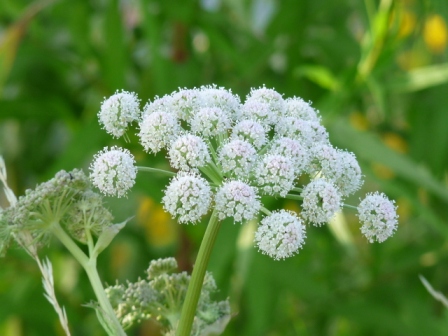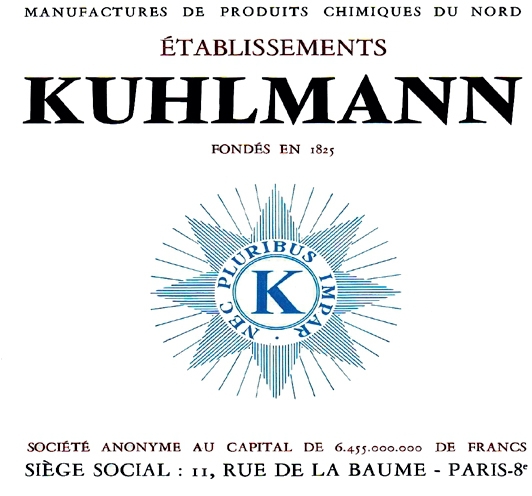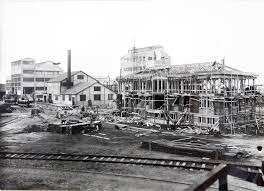The 13ARTS association, in partnership with the town of Paimboeuf, has initiated the creation of a time trail through the town with the participation of the 100pression collective and two of its artists: WIDE and Francis PERSU.
Paimboeuf residents, visitors, tourists and cyclists on the Loire cycle route were all able to see and witness the birth of three murals created by two members of the Nantes-based 100pression collective: WIDE and Francis PERSU. Embellishing the area and modernising the public space, asserting Paimbœuf’s strong identity, encouraging people to discover the town and developing its tourist appeal through a different form of art and expression – these are the ambitions of this project led by the 13ARTS association in partnership with the Commune.
The aim was to showcase the city’s maritime, historical, industrial and natural heritage through urban art.
The Hangar
The tour begins with a mysterious look at Jacques-Noël SANÉ, nicknamed “The Vauban of the Navy”.
Born in Brest in 1740 and died in Paris in 1831, he was the most brilliant French naval engineer of the age of sail.
Then, on the Loire side, we discover the boat “La Méduse”, built in Paimbœuf. Napoleon took an interest in it during his visit in 1808. It was inaugurated and acclaimed by the crowds on 1 July 1810, before sinking on 2 July 1816 with the loss of 160 lives, including 147 abandoned on a makeshift raft.
The shipwreck inspired Théodore Géricault in 1818-1819 to paint the monumental picture “Le Radeau de la Méduse” (The Raft of the Medusa), on display in the Louvre Museum.
The passage of the Acadians
A colourful mix inspired by Paimbœuf’s industrial past and its natural heritage.
You’ll find the Angélique des estuaires (feverweed), a rare French endemic plant that is threatened and protected. As well as Gratiola, also known as poor man’s grass or little foxglove…
The Kuhlmann factory is also represented here. For 80 years, the commune of Paimbœuf was home to the largest industrial centre in the south of the estuary, the Kuhlmann factory, which still employed more than 700 people in 1970. Very quickly active in fertiliser production, the industrial group pioneered the development of superphosphates. Until its closure in 1996, the site manufactured tetraethyl lead, an essential ingredient in petrol. By creating housing, sports clubs and a lean-to school, this factory left its mark on the history of Paimbœuf.
The courtyard of the Georges Brassens Cultural Centre
(26, boulevard Dumesnildot)
Pierre Chevry, owner of the Kuhlmann factory in Paimbœuf, is pictured here. Born in Haute-Marne in 1894, he was an engineer, a polytechnician and a member of the Resistance. One of the things he did was warn his employees before the Germans arrived. He died in deportation on 17 August 1944.
The factory was reborn and its logo (a blue K) and its motto NEC PLURIBUS IMPAR (Everything is possible for him) can be seen on the fresco.
Three murals in 3 locations:
– Le HANGAR, quai Sadi-Carnot
– Le Passage des Acadiens, quai Sadi-Carnot
– The courtyard of the Centre Culturel Georges-Brassens (26, boulevard Dumesnildot)
Who are they?
The 13ARTS association was set up by Carine and Gaël, two people with a passion for graffiti and industrial heritage. It has set up shop in the former Paimbœuf health centre on rue Pierre-Jubau to provide a venue for exhibitions and free multidisciplinary artistic expression. The association’s aim is to make culture accessible in a broad, cross-disciplinary way; to orchestrate encounters between audiences and artists; and to promote creativity, urban heritage and local talent through street art.
Persu has been active on the French graffiti scene since the early 90s, working under a variety of pseudonyms. It was with the L’OCT crew that he developed a technique that enabled him to create everything from simple flops to ultra-colourful frescoes. Although his characters and landscapes are inspired by comics, his speciality remains the ‘Wild style’, a complex style of lettering. Drawing tirelessly, it is the links between the letters that fascinate him and with which he plays the most.
Since childhood, Wide has been fascinated by abandoned spaces, ceded by man to the wild. These modern ruins remind us of our own temporality, of the impermanence of everything. For the past 20 years, he has been making paintings, which are by their very nature ephemeral, in these decaying places. This practice has developed Wide’s interest in the obsolescence produced by time, and has led him in this quest to aesthetise the ephemeral to Glitch art. This art consists of recognising beauty in the display errors of digital images, in the form of fragmentations, repetitions and artefacts.
Wide attempts to reproduce in painting the aesthetics of technological obsolescence that can appear on our LCD screens. Collecting passport photos, evidence of a moment in time, and capturing words taken from the stream of continuous information that is both ‘news’ and already out of date, constitute the raw material for Wide’s studio work. He explores these themes in works that tend towards abstraction, experimenting with different media and techniques.
Association 13ARTS Carine JOLY (President), 06 47 97 66 16 / 13arts.asso@gmail.com / www.facebook.com/13arts.asso
Collectif 100pression, 11 Rue des Olivettes, 44000 Nantes / 06 08 02 79 81
| Period (s) | Morning | Afternoon | Opening day | Closing day |
|---|
Individual visits
Free visit (permanence):yesFree visit (request):
Guided tour (permanence):
Guided tour (request):
Duration of the visit:
Free tasting:
Tasting fee:
Group tours
Free visit (permanence):yesFree visit (request):
Guided tour (permanence):
Guided tour (request):
Duration of the visit:
Free tasting:
Tasting fee:
-
Museum category
-
Modern / contemporary art
-
Town, village and district






